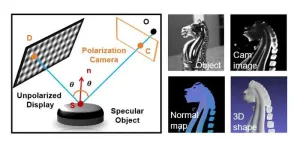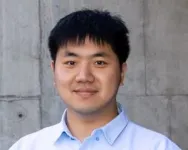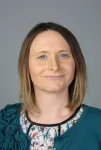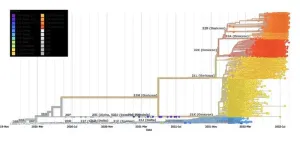(Press-News.org) Accurate and robust 3D imaging of specular, or mirror-like, surfaces is crucial in fields such as industrial inspection, medical imaging, virtual reality and cultural heritage preservation. Yet anyone who has visited a house of mirrors at an amusement park knows how difficult it is to judge the shape and distance of reflective objects.
This challenge also persists in science and engineering, where the accurate 3D imaging of specular surfaces has long been a focus in both optical metrology and computer vision research. While specialized techniques exist, their inherent limitations often confine them to narrow, domain-specific applications, preventing broader interdisciplinary use.
In a study published March 27 in the journal Optica, University of Arizona researchers from the Computational 3D Imaging and Measurement (3DIM) Lab at the Wyant College of Optical Sciences present a novel approach that significantly advances the 3D imaging of specular surfaces.
Their method seamlessly combines the information captured from two established techniques – Phase Measuring Deflectometry (PMD) and Shape from Polarization (SfP) – which are typically used in optical 3D metrology and computer vision research, respectively. In the new method, the benefits of both techniques complement each other in a manner never fully realized in previous work, paving the way for 3D imaging of specular objects that is both highly accurate and widely applicable.
Well-known for its high accuracy and precision, conventional Phase Measuring Deflectometry (PMD) is and is widely used in high-end applications to inspect optical lenses and telescopic mirrors or to detect defects in car bodies. However, PMD also comes with challenges.
Florian Willomitzer, associate professor of optical sciences, director of the 3DIM lab and principal investigator of the study explained: “In particular, PMD suffers from inherent ambiguity issues. Overcoming these challenges typically requires either additional hardware or prior knowledge about the object's shape and distance—limiting PMD’s flexibility for general use.
“On the other hand, Shape from Polarization (SfP) is a well-established 3D imaging method in the computer vision community that is highly flexible," he said. "However, certain geometric assumptions limit its accuracy. This restricts the method to applications with low accuracy requirements or purely qualitative inspection cases."
Bridging the gap between Optical 3D Metrology and Computer Vision Research
The team’s new technique integrates the strengths of PMD and SfP while overcoming their weaknesses. Leveraging the geometrical information from deflectometry with polarization cues, the surface shape and normal field of the specular object can be accurately reconstructed—without the need for prior knowledge about the object, complex setups, or specific assumptions about the imaging model.
“We developed a mathematically rigorous and creative approach to combine these two sets of information,” said Jiazhang Wang, postdoctoral associate in Willomitzer’s lab, first author and lead researcher of the study. “This results in a novel measurement technique that accurately determines the object’s shape and surface normals without the typical ambiguities, ensuring both high accuracy and wide applicability. In essence, our new method is bridging the current technology gap between optical 3D metrology and computer vision.”
Single-Shot 3D Reconstruction: A Leap Toward Practical Motion-Robust Measurements
Traditional PMD and SfP are “multi-shot” methods and require capturing 8 to 30 or more camera images in succession to reconstruct one single 3D model, making them highly susceptible to motion artifacts.
“The slightest movement during this sequence introduces severe reconstruction errors and renders the results unusable,” explained Wang. “By integrating novel hardware designs with advanced reconstruction algorithms, our method can now extract all required information from one single camera image. This can enable real-time, hand-guided measurements and high-speed imaging of dynamic scenes.”
Wang, Willomitzer and co-author Oliver Cossairt, adjunct associate professor in electrical and computer engineering at Willomitzer’s and Wang’s previous institution Northwestern University, shared their excitement for the study’s possibilities.
“The single-shot capability is a crucial advancement for applications where motion robustness is essential,” Wang said, “such as measuring fast-moving parts on a conveyor belt or scanning objects by hand-guiding the sensor.”
Pushing the Limits for Next-Generation 3D Sensors
A key aspect of this study was to understand and analyze the current limitations of 3D imaging on specular surfaces and use this knowledge to develop a sensor concept that overcomes these challenges while building upon the strengths of current PMD and SfP methods.
Willomitzer concluded that this way of tackling current imaging challenges has merit far beyond the “house of mirrors” problem of measuring specular surfaces.
“This mindset aligns closely with one of the core themes of our lab,” he said. “We strive to explore and exploit physical and information-theoretical limits to invent, develop and build the next generation of computational 3D imaging systems.”
END
Beyond ambiguous reflections: Bridging optical 3D metrology and computer vision
A new method that is both accurate and widely applicable paves the way for three-dimensional imaging of reflective object surfaces
2025-03-27
ELSE PRESS RELEASES FROM THIS DATE:
Baylor Anthropology scientist Julie Hoggarth, Ph.D., named AAAS Fellow
2025-03-27
Noted Maya archaeologist Julie Hoggarth, Ph.D., associate professor of anthropology at Baylor University, has been elected to the rank of AAAS Fellow, a lifetime honor announced today by the Council of the American Association for the Advancement of Science (AAAS), the world’s largest general scientific society and publisher of the Science family of journals.
Hoggarth is among the 471 scientists, engineers and innovators who have been elected 2024 Fellows for their scientifically and socially distinguished achievements throughout their careers. The new Fellow class hails from academic institutions, ...
Joint clinical commitment will advance integration of telehealth, value of patient care
2025-03-27
DALLAS, March 27, 2025 — Recent analysis by the National Health Institute indicates that telehealth now accounts for 23% of all health care encounters nationwide, with some clinical specialties reporting virtual visit rates now exceeding 50%.[1] To help ensure quality care in this rapidly expanding field, the American Heart Association Center for Telehealth and the National Institutes of Health-funded University of North Carolina Chapel Hill Center for Virtual Care Value and Excellence (UNC-Chapel Hill ViVE), are building ...
The Protein Society announces its 2025 Award Recipients
2025-03-27
FOR IMMEDIATE RELEASE
Contact:
Raluca Cadar
The Protein Society
Phone: (844) 377-6834
E-mail: rcadar@proteinsociety.org
LOS ANGELES, CA – The Protein Society, the premier international society dedicated to supporting protein research, announces the winners of the 2025 Protein Society Awards, which will be recognized at the 39th Annual Symposium, June 26 – 29, 2025, in San Francisco, USA. Plenary talks from award recipients will take place throughout the 3.5-day event. The winners’ scientific accomplishments, described by their nominators below, demonstrate their profound impact on protein science.
The Christian B. Anfinsen ...
AI is as good as pathologists at diagnosing celiac disease, study finds
2025-03-27
A machine learning algorithm developed by Cambridge scientists was able to correctly identify in 97 cases out of 100 whether or not an individual had coeliac disease based on their biopsy, new research has shown.
The AI tool, which has been trained on almost 3,400 scanned biopsies from four NHS hospitals, could speed up diagnosis of the condition and take pressure off stretched healthcare resources, as well as improving diagnosis in developing nations, where shortages of pathologists are severe.
Digital ...
AI could help sonographers identify abnormalities in unborn babies more quickly
2025-03-27
Artificial intelligence (AI) could help sonographers identify any abnormalities at the 20-week pregnancy screening scan almost twice as quickly, without reducing the accuracy or reliability of diagnoses, a new study has shown.
This will help improve patient care by allowing sonographers to focus on other aspects of the scan, such as communicating with parents or spending more time looking at any areas of concern.
The trial is the first of its kind to use AI for the 20-week pregnancy scan on real patients, and is ...
First clinical trial of an AI therapy chatbot yields significant mental health benefits
2025-03-27
Dartmouth researchers conducted the first clinical trial of a therapy chatbot powered by generative AI and found that the software resulted in significant improvements in participants' symptoms, according to results published March 27 in the New England Journal of Medicine AI.
People in the study also reported they could trust and communicate with the system, known as Therabot, to a degree that is comparable to working with a mental-health professional.
The trial consisted of 106 people from across the United States diagnosed with major depressive disorder, generalized anxiety disorder, or an eating disorder. ...
AI learns to ‘speak’ genetic ‘dialect’ for future SARS-CoV-2 mutation prediction
2025-03-27
It’s been five years since COVID-19 was declared a global pandemic. As SARS-CoV-2 shifts to endemic status, questions about its future evolution remain. New variants of the virus will likely emerge, driven by positive selection for traits such as increased transmissibility, longer infection duration and the ability to evade immune defenses. These changes could allow the virus to spread among previously immunized populations, potentially triggering new waves of infection.
Predicting new mutations in viruses is crucial for advancing life science research, particularly when trying to understand how viruses evolve, ...
$50 million gift from the Weill Family Foundation establishes the Weill Cancer Hub East
2025-03-27
New York, N.Y., and Princeton, N.J. (March 27, 2025)—With a mission to understand how nutrition and metabolism impact the body’s ability to control cancer, four leading research institutions have united under the Weill Cancer Hub East, an innovative, collaborative partnership that aims to transform cancer treatment. The initiative connects world-class experts from Princeton University, The Rockefeller University, Weill Cornell Medicine and the Ludwig Institute for Cancer Research to enhance a ...
Physics meets art: a new twist on interference patterns
2025-03-27
Tokyo, Japan – One of the simplest and most beautiful naturally occurring patterns can be observed when light is shined through a pair of slightly misaligned periodic structures. This phenomenon, known as the moiré effect, is not only pretty to look at, but also has important consequences for the properties of materials.
In an article published in ACS Nano, a team led by researchers from the Institute of Industrial Science, The University of Tokyo, announced the discovery of a previously unseen moiré pattern: a series of periodic one-dimensional bands in tungsten ditelluride bilayers.
In nanomaterials, moiré patterns ...
Elevating global heart failure care with new certification
2025-03-27
DALLAS, March 27, 2025 — More than 56 million people globally live with heart failure (HF), which prevents the body from getting enough of the oxygen-rich blood it needs to work properly.[1]
While there is no cure for HF, many people with this condition can live full, enjoyable lives and disease progression can be slowed with the right treatment. Research shows that outcomes for patients with HF improve when health care professionals and hospitals provide guideline-directed medical therapies.
A new Heart Failure Center ...
LAST 30 PRESS RELEASES:
Numbers in our sights affect how we perceive space
SIMJ announces global collaborative book project in commemoration of its 75th anniversary
Air pollution exposure and birth weight
Obstructive sleep apnea risk and mental health conditions among older adults
How talking slows eye movements behind the wheel
The Ceramic Society of Japan’s Oxoate Ceramics Research Association launches new international book project
Heart-brain connection: international study reveals the role of the vagus nerve in keeping the heart young
Researchers identify Rb1 as a predictive biomarker for a new therapeutic strategy in some breast cancers
Survey reveals ethical gaps slowing AI adoption in pediatric surgery
Stimulant ADHD medications work differently than thought
AI overestimates how smart people are, according to HSE economists
HSE researchers create genome-wide map of quadruplexes
Scientists boost cell "powerhouses" to burn more calories
Automatic label checking: The missing step in making reliable medical AI
Low daily alcohol intake linked to 50% heightened mouth cancer risk in India
American Meteorological Society announces Rick Spinrad as 2026 President-Elect
Biomass-based carbon capture spotlighted in newly released global climate webinar recording
Illuminating invisible nano pollutants: advanced bioimaging tracks the full journey of emerging nanoscale contaminants in living systems
How does age affect recovery from spinal cord injury?
Novel AI tool offers prognosis for patients with head and neck cancer
Fathers’ microplastic exposure tied to their children’s metabolic problems
Research validates laboratory model for studying high-grade serous ovarian cancer
SIR 2026 delivers transformative breakthroughs in minimally invasive medicine to improve patient care
Stem Cell Reports most downloaded papers of 2025 highlight the breadth and impact of stem cell research
Oxford-led study estimates NHS spends around 3% of its primary and secondary care budget on the health impacts of heat and cold in England
A researcher’s long quest leads to a smart composite breakthrough
Urban wild bees act as “microbial sensors” of city health.
New study finds where you live affects recovery after a hip fracture
Forecasting the impact of fully automated vehicle adoption on US road traffic injuries
Alcohol-related hospitalizations from 2016 to 2022
[Press-News.org] Beyond ambiguous reflections: Bridging optical 3D metrology and computer visionA new method that is both accurate and widely applicable paves the way for three-dimensional imaging of reflective object surfaces








